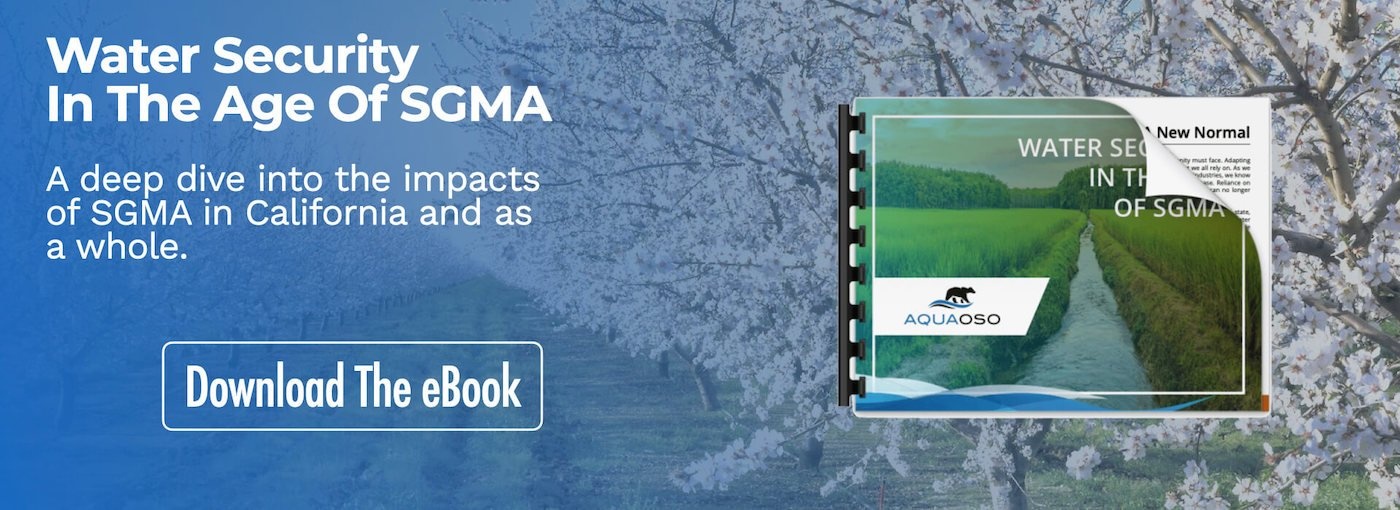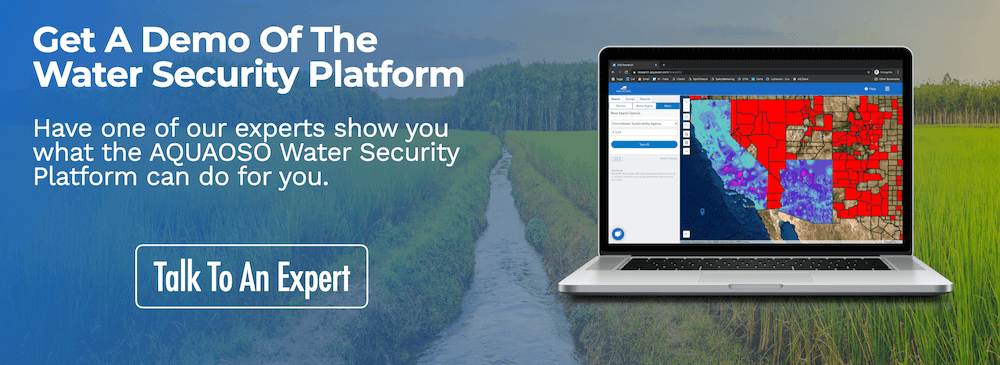Water Cost Trends in Agriculture and Water Markets for 2021
Part of our Water Trends Guide
Water costs can be one of the most unpredictable trends in agriculture. In 2015, when California experienced severe drought conditions, water sales reached an annual high of $800 million, compared to $300 million in less dry years. And in 2018, a drought in Argentina caused the price of livestock feed to increase around the world.
As BlackRock’s Troubled Waters investment report explains, water scarcity can have effects on the entire supply chain, not just the cost of water itself:
“Companies in water-stressed locations … may need to spend more to mitigate the effects of water stress, such as investments in water efficiency, pollution abatement, water re-use, recycling, and conservation measures.”
In this article, we’re going to look at some of the most important water cost trends in agriculture for 2021, including:
- The global value of water in agriculture
- The “shadow price” of irrigation water
- Water market trends by state
This data is not intended to be concrete facts, nor is it meant to be legal advice of any kind. It is intended to provide insight and spark ideas around the valuation of water and how it relates to crop values, land deals, and agricultural investments.
The Global Value of Water in Agriculture
Right now, it can be hard to put a price on water – both literally and figuratively. While water markets are seen as a potential opportunity to allocate water more efficiently, there’s currently no standard pricing mechanism that applies across the board. Surface water and groundwater rights are priced differently, as are permanent sales versus leases.
A report from U.C. Berkeley explains: “The value of water … remains difficult to estimate because water markets and market prices exist only in a few regions of the world.” But at the same time, “an international agreement on water valuation is … considered to be crucial to the achievement of an efficient and sustainable global water use.”
The researchers behind the report developed a complex formula (that you can see in full detail here) to estimate a global price for irrigation water based on the “increased value of crop production.”
They determined that the global mean water values for five major crops are:
- Wheat $0.05/m3
- Maize $0.16/m3
- Rice $0.16/m3
- Soybean $0.10/m3
- Potatoes $0.67/m3
To be clear, these figures aren’t intended to be a suggested price that farmers should be willing to buy or sell water for, but are simply an academic attempt to determine the true value of water from a global perspective. The researchers note that actual market prices are similar. For example, in Colorado, farmers paid between $0.02 to $0.08/m3 in 2012.
What complicates matters is the fact that farmers aren’t the only ones bidding on water; in Texas, oil companies began using computer applications to buy water rights: “While farmers would normally pay $0.05/m3, in periods of water scarcity, competition with shale oil and gas companies have brought the price to up to $2.50/m3.”
This suggests that competition for water from more lucrative industries can drive prices up, impacting the trajectory of water cost trends in agriculture.
The “Shadow Price” of Irrigation Water
Another way of looking at water cost in agriculture is to consider the “shadow price,” or the current marginal value of water based on “the maximum price the farmer is willing to pay for the last cubic meter of irrigation water consumed.” While similar to the previous metrics we looked at, researchers at the American Geophysical Union used a different formula to calculate the shadow price of five major crops.
They argue that a lack of competitive water pricing leads to the over depletion of aquifers by not accounting for the true cost of water, for example, by leaving out the “opportunity costs” associated with limited future use or with environmental degradation.
They determined that the shadow prices of five major crops in the U.S. are:
- Wheat 0.064/m3
- Potato 0.054/m3
- Maize 0.299/m3
- Rice 0.013/m3
- Citrus 0.113/m3
Using this data, they estimated the potential for increased revenue or reduced depletion of groundwater resources by “reallocating a considerable amount of irrigation water (IW) consumption from one staple crop to another.” In the U.S., this reallocation could save as much as 6% of the country’s “nonrenewable groundwater consumption.”
Again, this data should not be used as a concrete suggestion of what water prices should be. Rather, this is an example of what water valuation could be or even an example of how to get started.
Water Market Trends by State
Finally, we can look at data from existing water markets to see where water trades are currently happening and what water cost trends we can expect to see in each state.
According to a review published in 2020, both the volume and the value of water traded in California exceeds that of any other state. However, Arizona trades more water (4%) as a percentage of the total water used, compared to only 2% in California.
In some states, leases are more common, while in others, the majority of water trades take the form of permanent sales. Because permanent sales fetch a higher price, they make up a large portion of the value traded, but a smaller percentage of acre-feet.
In 2013, permanent sales averaged $3797 per acre-foot in California but reached as high as $9230 per acre-foot in 2014 due to drought.
From 2009 – 2018, the average total water sales by state per year were as follows:
| Sales ($) | Leases ($) | Sales (AF) | Leases (AF) | |
| Arizona | $12 million | $39 million | 14,000 | 288,000 |
| California | $100 million | $295 million | 29,000 | 1,065,000 |
| Colorado | $89 million | $8 million | 15,000 | 45,000 |
| Texas | $34 million | $26 million | 30,000 | 178,000 |
While the total amount of water that’s traded in each state is still small compared to the total amount of water used, we can expect to see increased interest in water trading in 2021, especially as more regions roll out smart water markets, and as regulations like SGMA come into effect to encourage more efficient use of groundwater resources.
Why Water Cost Matters
Water cost trends in agriculture can seem either too unpredictable or too hypothetical to factor into land deals and other agricultural investments. But as BlackRock explains, it’s going to become increasingly impossible to leave water out of the equation:
“Global water infrastructure costs are expected to rise fourfold to $150 billion annually from 2017 levels by 2030, the World Bank estimates.”
Whether you’re tracking the cost of acre-feet of groundwater in a region or the shadow price of a particular crop, having a realistic understanding of water cost matters. As the team at U.C. Berkeley puts it:
“The value of irrigation water in agricultural areas is an important piece of information for investors and financial groups engaged in the acquisition of land and water resources… To make an informed decision about the acquisition or relinquishment of water rights or about investments in irrigation infrastructure there is a need for a better understanding of the value generated by irrigation water in agriculture.”
Having up-to-date information can go a long way toward protecting your own financial stake in agriculture, while also supporting the farmers and growers you work with. By collecting and sharing data on water costs and other trends, we can work together to allocate resources more efficiently and invest in necessary infrastructure projects.
Read our Water Trends Guide for current information curated to aid you in decisions around water.
The Bottom Line
At AQUAOSO, we’re working toward more transparency in the water sector by providing up-to-date, accurate information on water risk through our Water Security Platform. We’re here when it comes to navigating the latest trends, regulations, and water scarcity issues in the agricultural industry across a growing number of states. We want to help.
Investors, lenders, and growers alike use our platform to gain insight into water and soil assets by region or on a parcel-by-parcel basis, all in one central database.
Browse our resources to learn more about the topics mentioned in this article, or contact us directly to find out how we can help you better understand water risk.
Recent Posts
Sustainable Agriculture Practices That Need Financial Capital
In late 2021, world leaders gathered in Glasgow for COP26, better known as the UN’s climate change conference. With over 25,000 attendees meeting to discuss the efforts needed to address climate change, themes of sustainability, renewable energy and the reduction of...
2022 Sustainable Agriculture Trends for Ag Finance to Be Aware of
With real-world impacts like rising global temperatures, climate change is one of the biggest risk factors agriculture faces today. NOAA reported that 2020 was the second warmest year and the EPA explains a consistent increase of 0.16°F in average surface temperature...
Crucial Ways Agricultural Bank Services Can Contribute to A Sustainable Ag Economy
Ag banks and Farm Credits, enable agribusinesses to attain the financing they need in order to execute functions like harvesting and planting, as well as buying new equipment and combat overhead costs. They allow farmers to operate by engaging in a relationship with...






